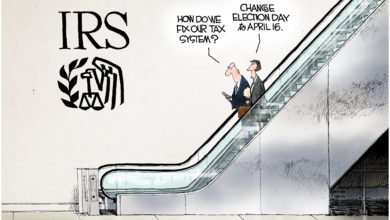Government and Corporate Financing to Tackle “Climate Change” Is Rising—and It’s Personal
Have you noticed that one of the best marketing strategies creates a personal connection between yourself and the service the marketer wants you to purchase? So by the time you’ve taken steps to subscribe to that promoted monthly program, you are convinced and almost feel justified it was the “right thing to do.”
Indeed, the art of marketing is a precise method of psychological and emotional influence. And it wasn’t long ago that the international lobbying organization, the World Economic Forum (WEF), published an article justifying the necessity of surveilling carbon emissions at a very—very personal level.
My. Carbon.
That’s right.
The “My Carbon” initiative would allow individuals to monitor their own carbon footprint through a “personal allowance program.” Authored by India’s Ministry of Housing and Urban Affairs Smart Cities Mission director, the article promotes “inclusivity of citizens” in reducing carbon emissions in metropolitan areas, otherwise known as “sustainable cities.”
According to the author, numerous examples of “personal carbon allowance programs” have been in discussions for the last two decades. Yet, a lack of social and political acceptance for tracking emissions has hampered the successful implementation of such initiatives.
Ideas around tracking or monitoring a person’s carbon footprint aren’t entirely new; however, smartphone technology advancements and the mainstream narrative on “climate change” has arguably enabled them to gain momentum in recent years.
Since the share of individual carbon emissions is “significant” at around 40 percent, the My Carbon initiative addresses the need for personal allowances through WEF’s signature strategy of public-private partnerships.
Indeed, the author argues that the response to COVID-19 spurred “wearing masks, mass vaccinations and acceptance of contact-tracing applications for public health” measures by “billions of citizens across the world.” Thus, a natural progression would be taking “social responsibility” for how much carbon is produced on an individual level. But if someone refuses a government or corporate-issued incentivized carbon allowance program, will they be left alone without harassment?
My Carbon builds upon technologies such as “the roll-out of smart meters in providing individual choices to reduce their energy-related emissions,” and the development of personalized apps as a proper step towards delivering “awareness on the choices of personal carbon for food, transport, home energy and lifestyle choices.”
Notice how the word “choice” is emphasized; the goal involves convincing the masses that they aren’t being pressured but rather taking “social responsibility” using free will. However, how long will this “choice” last when introduced on a large scale to everyday people?
Furthermore, the increased awareness among young people around “climate change” is justified by a 2021 Pew Research Center survey and climate change protests as a step in the right direction towards facilitating My Carbon goals: increase costs for carbon-intensive activities and goods; provide incentives to reduce carbon demand; raise awareness of personal carbon footprints towards a net-zero carbon future; define “a fair share” and set “acceptable levels” of individual emissions.
Indeed, young people represent not only our nation’s future but are one of society’s main agents of change—in cultural, economic and political directions. And to that end, the youth are highly susceptible and vulnerable to a wide range of ideas compared to their stubborn older counterparts, as justified in the article, “Get ‘Em Young Using Predictive Programming in Cartoons—and Why Your Awareness Is Power.”
A note, dear reader: the WEF labels almost every published piece with the disclaimer, “The views expressed in this article are those of the author alone and not the World Economic Forum.” So that’s just great; no need to worry.
Nearly a year before millions of people went into lockdown due to government-issued orders, Swedish fintech company Doconomy launched a credit card that monitors purchases by counting carbon emissions—and puts a spending cap based on the amount emitted.
The “Do Black” credit card is part of a partnership with Mastercard and the United Nations Framework Convention on Climate Change to facilitate reducing carbon emissions by 50 percent towards the next decade.
Every purchase using Doconomy’s card generates a carbon footprint using the Aland Index, which is displayed on a smartphone app. With a monthly carbon dioxide (CO2) limit, cardholders will be denied spending once they have used up their allowance.
According to Doconomy’s CEO Mathias Wikström, “It is more important that everyone track, measure and reduce their [CO2] impact than that they use the cards. However, if the card can assist in educating the user then that is a perfect match.”
Furthermore, the company’s former CEO says in a marketing video, “The core purpose of Do Black is not only the ability to measure the impact of your [carbon] consumption, but also bringing it to a direct halt, making it a radical tool against climate change.”
Unsurprisingly, the WEF praised Doconomy’s initiative and added that the idea behind “offsetting carbon at the point of transaction” is slowly being picked up by companies from airlines to ice cream manufacturers.
Fast forward to early 2021. Aspiration, a fintech company that specializes in “sustainability” products for consumers and businesses, launched its own “Aspiration Zero” credit card in partnership with Mastercard.
The goal of Aspiration Zero is to facilitate the cardholder to reach “carbon neutrality.” A tree is planted for every purchase made, and Aspiration estimates planting 60 trees a month will achieve this goal. Once a cardholder becomes “carbon neutral,” they are offered a 1-percent cash back reward on all eligible purchases.
And there’s no shortage of corporate initiatives. For example, towards the end of 2021, Mastercard announced it was partnering with British universal bank Barclays to launch the “cards and payments challenge.” Indeed, this “challenge” involves attracting and financing fintech startups to develop digital payment systems with a focus on decarbonization, and “help tackle climate change.”
Therefore, while everyday people may apply for a carbon credit card should they feel a “social responsibility” to monitor their CO2 emissions, governments are helping to steer automakers towards producing low-carbon-emitting vehicles.
According to a March 2022 article by Bloomberg Tax, the Securities and Exchange Commission (SEC) had demanded Tesla justify combining vehicle sales with “government credit” sales in its 2020 annual 10-K form. It was revealed that the sales of these credits amounted to nearly $1.5 billion in 2021, while Tesla reported a net income of $5.52 billion for the year alone. To this end, Tesla stated in a February letter that it was “extremely transparent” about the impact of such credits on the company’s performance.
Led by CEO Elon Musk, Tesla earns tradeable government credits, also known as “regulatory” or “carbon” credits, to produce zero-emission vehicles (ZEVs). Automakers building low-emitting carbon vehicles or ZEVs receive credits based on factors such as the range covered per fully charged battery. In addition, such companies must accumulate a certain amount of yearly regulatory credits, and it’s possible to buy these from other automakers with excess credits.
Since Tesla sells vehicles exclusively under the ZEV category, the company typically has excess regulatory credits to sell to other automakers short of these credits. Indeed, according to its annual filing, Tesla’s sale of these credits skyrocketed from $986 million (2019) to $1.58 billion (2020) and $1.46 billion (2021.)
In fact, Tesla’s recorded profit hasn’t just materialized due to electric vehicle sales, which is arguably the primary business of an automaker. Sales of carbon credits accounted for $518 million in revenue for the first quarter of 2021, which saw a net income of $438 million on a Generally Accepted Accounting Principles basis. An upward trend saw the company hit $679 million credit sales for the first quarter of 2022.
Furthermore, Tesla didn’t only cash in on carbon credits as an automaker of “green” vehicles. The company also sold bitcoin cryptocurrency (digital currency) in the first quarter of 2021, amounting to $101 million in profits. According to an SEC filing in early 2021, Tesla had purchased $1.5 billion worth of bitcoin and began accepting the cryptocurrency for sales of its cars. Later that year, Musk tweeted that Tesla had “suspended vehicle purchases using bitcoin” due to concern over the “rapidly increasing use of fossil fuels for bitcoin mining.” In other words, he suspended an activity that would have prevented stacks of government-issued carbon credits.
At least 13 states have rules surrounding carbon credits; they require automakers to produce a certain number of “green” vehicles based on the total number of cars sold in that particular state.
Government incentives have been introduced for automakers to develop ZEVs or very low-carbon-emitting cars: when a company receives a single carbon credit representing a tradeable measurement unit, it gains permission to emit one ton of carbon dioxide equivalent (CO2e.)
America isn’t alone in the carbon credit scheme. Consider China, the European Union (E.U.) and the United Kingdom (U.K.)
-
Chinese regulations determine the amount of credit per vehicle using factors such as the range covered per fully charged battery. Tesla has sold more than a million cars in China and earns carbon credits. The country has an important automotive industry; Reuters reported in 2021 that a joint venture between the German automaker Volkswagen and Chinese state-owned manufacturer FAW agreed to purchase credits from Tesla to comply with China’s environmental rules.
-
In early 2020, the E.U. legislated that CO2 car emissions must not exceed 95 grams per kilometer, and any automaker surpassing its target would be fined. In addition, there are incentives in a “super-credits system” to drive the development of vehicles that emit less than 50 grams per kilometer.
-
After exiting the E.U., the U.K. government published its CO2 emission standards for vehicles in late 2020 (similar E.U. rules still apply.) A fine of roughly $105 applies for every gram per kilometer an automaker exceeds its annual target, which is then multiplied by the number of vehicles sold that year.
Carbon credits are also issued to other industries that have achieved a pre-set reduction in carbon emissions. Hence, in a “carbon credit exchange” market, businesses use the credits like currency to purchase carbon offsets—which represent measurement units to compensate for investing in a “green” initiative that removes CO2e.
For individuals thinking about trading on the carbon credit exchange, it might be worthwhile to note the risks, including financial losses due to market volatility. But, in fact, there is another emerging layer to this exchange market.
And it’s big—big business.
Welcome cryptocurrency or crypto—a digital currency that is not reliant on any central government bank—to trading, buying and selling carbon credits.
It was reported in late September that a digital assets (e.g., cryptocurrencies) trading platform, 1GCX, partnered with a proprietary trading firm, T3 Trading, raising $2 billion in assets under management. The partnership also set up a $100 million liquidity pool, that is, a collection of digital assets locked in a smart contract to facilitate such credit transactions.
While 1GCX offers cryptocurrency, commodities and carbon offset trading, T3 Trading invests in cryptocurrency and carbon offsets. Thus, this business alliance aims to support carbon credits’ market growth and accelerate 1GCX in establishing a standard for buying and selling credits. Indeed, according to the company’s President and COO Michael Wilson:
“Carbon credits have the potential to scale to a multi-trillion dollar market over the next several years, but the market opportunity is still relatively untapped as the sector continues to mature.”
The partnership, which bridges digital and carbon assets, capitalizes on investors’ interests in both sectors and aims to attract those familiar with carbon assets but new to digital assets.
So there you have it, folks.
All government incentives and business deals around carbon credits are supposedly designed to help the world halve carbon emissions by 2030 and reach net-zero emissions by 2050. Yet there is one guarantee by every decade: large corporations and financial institutions will keep making big money.
So while companies like Tesla and Mastercard strive to reach the virtuous goal of saving the planet, everyday people might want to pay attention to possible CO2 limits on their regular credit card, a possible net-zero program in their corporate role or even the possible requirement they use low-carbon-emitting transport to work.
The greater the limits in the name of the “common good,” “saving the planet”, or “fighting climate change,” the more significant the restrictions and scrutiny on the individual.
We get what we’re willing to tolerate.
What are we willing to tolerate not just for our future but our children’s and grandchildren’s future?
Content syndicated from Dear Rest of America with permission
Agree/Disagree with the author(s)? Let them know in the comments below and be heard by 10’s of thousands of CDN readers each day!






It’s all part of the Globalist “Great Reset” that embeds the environmental scam in all government policies such as ESG scores and incentives for private business to not lend money or invest in businesses that are not politically favored. Last year we watched the country with the highest ESG score on the planet (Sri Lanka) collapse because their ban on chemical fertilizer collapsed their food production. Massive protests in the Netherlands for the same reason. We can also watch in real time Europe collapsing and miles long gas lines after decades of their “Green New Deal” policies made them totally dependent on Russian gas and oil. In some places, energy costs have increased 1000% and businesses are closing because they can’t afford their utility bills. They’re clear cutting their forests, desperately digging for coal, and preparing for a brutal and dangerous winter.
What’s even more insane is that Biden and the Democrats passed their 730 billion dollar Green Energy bill, laughably called the “Inflation Reduction Act” to institute all these proven failed policies here. It’s nothing but a Green New Deal slush fund that includes such insanity as 60 billion dollars for “environmental justice”. And then there’s the four or five states that want to ban gas powered cars by 2030. Never mind that most all of the rare earth minerals for car batteries are mined in China or in Africa by child slave labor. Or that almost all of our solar panels come from China. Or that China is the worst polluting country in the world and is building coal fired plants as fast as they can and laughing at our idiocy and how we will continue to make them rich.
Americans need to wake up before it’s too late and realize that the middle class will be bankrupted by our own government’s never ending money printing (which in the main cause of inflation) and ever increasing taxes and higher and higher energy costs that will result from their idiotic “Green” policies and mandates